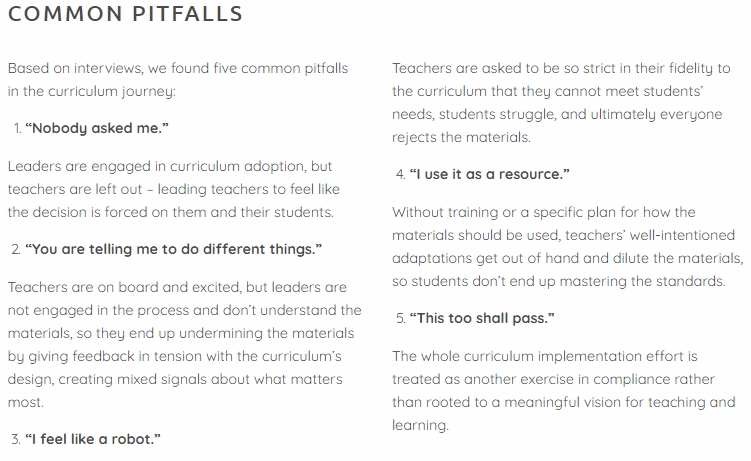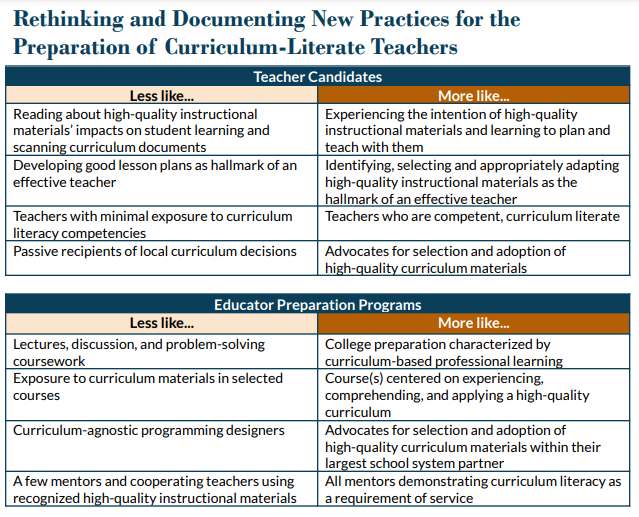The benefits of using high-quality instructional materials were outlined in previous lessons. Many studies have looked at the effects of strong teachers implementing quality instruction and using the right materials in the classroom. High-quality curricula aligned to standards are at the heart of student progress and equity in schools. But all too often, education leaders overlook curriculum as one of the pillars of school improvement.
According to Learning First and John Hopkins School of Education's study Curriculum Literacy in Schools of Education: The Hole at the Center of American Teacher Preparation, teachers are under-prepared to select and develop quality curriculum. Because the United States has a "lack of national consensus about the proper content for our classrooms," most teacher preparation programs do not emphasize defined content for subject matter.
Many educators will remember their "methods courses" as part of the preparation for teaching. While these courses prepare educators for creating effective learning environments and using technology, among other outcomes, they typically do not touch on specific curriculum or content. Because of this, methods courses can lead educators to believe that authentic teaching is teaching from self-created lessons and materials not directly related to formal curricula
In 2020, the National Center for Teacher Residencies (NCTR) and EdReports worked together to provide new teachers with information and support to help them use high-quality instructional materials in their classrooms. The report Preparing Day One Ready Teachers by Tabitha Grossman, Ph.D. and Stephanie Hirsch, Ph.D. presents first-year educator's assumptions regarding what good teaching looks like and what good teachers do:
These assumptions are evidence of the need for curriculum literacy in emerging first-year educators, but also in veteran teachers across the country.
Despite different understandings of what curriculum is and why it is important, it is never too late for educators to learn more about this essential part of student growth and school equity. In Curriculum Literacy in Schools of Education: The Hole at the Center of American Teacher Preparation, David Steiner of Johns Hopkins explains curriculum as, "the means to achieve the goals expressed in the standards. It is the teaching and learning program, and can include lesson plans and activities, scope and sequence documents, textbooks, computer programs, and even related pedagogical advice and embedded formative assessments."
Steiner explains curriculum literacy as, "the ability of teachers to identify and remedy deficiencies in instructional materials they are given to teach."
In addition, Steiner outlines basic competencies for curriculum literacy:
Steiner's explanation of curriculum and curriculum literacy as well as the competencies provide a shared language for educators and are essential to evolving the understanding of the importance of high-quality curricula for student learning.
The pilot program in the NCTR and EdReports study was a residency model. However, the project and its lessons can be applied to other teacher preparation programs both at the university level and within primary and secondary schools as well. Colleges will provide schools with curriculum-literate educators by examining their own profile of a graduate. Higher learning institutions can also partner with schools to build a team of interested educators who wish to learn more about how to use high-quality instructional materials and prioritize their use for new teachers. Using key tools such as the Ohio Curriculum Support Guide as well as data from both veteran and entry-level educators, schools can build teams to begin rethinking their approach to mentorships. Sharing the results of these practices will strengthen other programs and lead to a common language for educators across the state who can identify and correct the weaknesses in the instructional materials they are using.
Consider the two graphics as resources to help you begin the discussion of curriculum literacy in your own school.
Instructional Partners' Background for Ohio Curriculum Support Guide

Preparing Day One Ready Teachers

Fetch is avaiable to INFOhio automated schools. If you are an INFOhio school, please log in with your school username/password using the button at the top-left corner of this page.
For more information about Fetch, please visit the Fetch information page or contact INFOhio support at https://support.infohio.org.